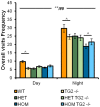Genetic deletion of transglutaminase 2 does not rescue the phenotypic deficits observed in R6/2 and zQ175 mouse models of Huntington's disease
- PMID: 24955833
- PMCID: PMC4067284
- DOI: 10.1371/journal.pone.0099520
Genetic deletion of transglutaminase 2 does not rescue the phenotypic deficits observed in R6/2 and zQ175 mouse models of Huntington's disease
Abstract
Huntington's disease (HD) is an autosomal dominant, progressive neurodegenerative disorder caused by expansion of CAG repeats in the huntingtin gene. Tissue transglutaminase 2 (TG2), a multi-functional enzyme, was found to be increased both in HD patients and in mouse models of the disease. Furthermore, beneficial effects have been reported from the genetic ablation of TG2 in R6/2 and R6/1 mouse lines. To further evaluate the validity of this target for the treatment of HD, we examined the effects of TG2 deletion in two genetic mouse models of HD: R6/2 CAG 240 and zQ175 knock in (KI). Contrary to previous reports, under rigorous experimental conditions we found that TG2 ablation had no effect on either motor or cognitive deficits, or on the weight loss. In addition, under optimal husbandry conditions, TG2 ablation did not extend R6/2 lifespan. Moreover, TG2 deletion did not change the huntingtin aggregate load in cortex or striatum and did not decrease the brain atrophy observed in either mouse line. Finally, no amelioration of the dysregulation of striatal and cortical gene markers was detected. We conclude that TG2 is not a valid therapeutic target for the treatment of HD.
Conflict of interest statement
Figures














Similar articles
-
Tissue transglutaminase overexpression does not modify the disease phenotype of the R6/2 mouse model of Huntington's disease.Exp Neurol. 2012 Sep;237(1):78-89. doi: 10.1016/j.expneurol.2012.05.015. Epub 2012 Jun 12. Exp Neurol. 2012. PMID: 22698685 Free PMC article.
-
Tissue transglutaminase contributes to disease progression in the R6/2 Huntington's disease mouse model via aggregate-independent mechanisms.J Neurochem. 2005 Jan;92(1):83-92. doi: 10.1111/j.1471-4159.2004.02839.x. J Neurochem. 2005. PMID: 15606898
-
'Tissue' transglutaminase ablation reduces neuronal death and prolongs survival in a mouse model of Huntington's disease.Cell Death Differ. 2002 Sep;9(9):873-80. doi: 10.1038/sj.cdd.4401093. Cell Death Differ. 2002. PMID: 12181738
-
Type 2 transglutaminase in Huntington's disease: a double-edged sword with clinical potential.J Intern Med. 2010 Nov;268(5):419-31. doi: 10.1111/j.1365-2796.2010.02275.x. J Intern Med. 2010. PMID: 20964734 Free PMC article. Review.
-
Comparative analysis of pathology and behavioural phenotypes in mouse models of Huntington's disease.Brain Res Bull. 2012 Jun 1;88(2-3):81-93. doi: 10.1016/j.brainresbull.2011.10.002. Epub 2011 Oct 8. Brain Res Bull. 2012. PMID: 22004616 Review.
Cited by
-
Therapeutic Applications of Cysteamine and Cystamine in Neurodegenerative and Neuropsychiatric Diseases.Front Neurol. 2019 Dec 12;10:1315. doi: 10.3389/fneur.2019.01315. eCollection 2019. Front Neurol. 2019. PMID: 31920936 Free PMC article. Review.
-
Inhibition of transglutaminase exacerbates polyglutamine-induced neurotoxicity by increasing the aggregation of mutant ataxin-3 in an SCA3 Drosophila model.Neurotox Res. 2015 Apr;27(3):259-67. doi: 10.1007/s12640-014-9506-8. Epub 2014 Dec 11. Neurotox Res. 2015. PMID: 25501875
-
Biomarker Analysis of Orally Dosed, Dual Active, Matrix Metalloproteinase (MMP)-2 and MMP-9 Inhibitor, AQU-118, in the Spinal Nerve Ligation (SNL) Rat Model of Neuropathic Pain.Int J Mol Sci. 2019 Feb 14;20(4):811. doi: 10.3390/ijms20040811. Int J Mol Sci. 2019. PMID: 30769782 Free PMC article.
-
Positive allosteric modulation of the type 1 cannabinoid receptor reduces the signs and symptoms of Huntington's disease in the R6/2 mouse model.Neuropharmacology. 2019 Jun;151:1-12. doi: 10.1016/j.neuropharm.2019.03.033. Epub 2019 Mar 30. Neuropharmacology. 2019. PMID: 30940536 Free PMC article.
-
Cooperation of cell adhesion and autophagy in the brain: Functional roles in development and neurodegenerative disease.Matrix Biol Plus. 2021 Oct 23;12:100089. doi: 10.1016/j.mbplus.2021.100089. eCollection 2021 Dec. Matrix Biol Plus. 2021. PMID: 34786551 Free PMC article. Review.
References
-
- Greenberg CS, Birckbichler PJ, Rice RH (1991) Transglutaminases: multifunctional cross-linking enzymes that stabilize tissues. FASEB J 5: 3071–3077. - PubMed
-
- Im MJ, Riek RP, Graham RM (1990) A novel guanine nucleotide-binding protein coupled to the alpha 1-adrenergic receptor. II. Purification, characterization, and reconstitution. J Biol Chem 265: 18952–18960. - PubMed
-
- Lai TS, Slaughter TF, Peoples KA, Hettasch JM, Greenberg CS (1998) Regulation of human tissue transglutaminase function by magnesium-nucleotide complexes. Identification of distinct binding sites for Mg-GTP and Mg-ATP. J Biol Chem 273: 1776–1781. - PubMed
-
- Mastroberardino PG, Farrace MG, Viti I, Pavone F, Fimia GM, et al. (2006) “Tissue” transglutaminase contributes to the formation of disulphide bridges in proteins of mitochondrial respiratory complexes. Biochim Biophys Acta 1757: 1357–1365. - PubMed
Publication types
MeSH terms
Substances
LinkOut - more resources
Full Text Sources
Other Literature Sources
Medical
Molecular Biology Databases

